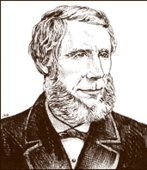John Tyndall

Tyndall, John
| Topics: |
John Tyndall (1820–1893) was a British physicist who produced early, seminal advances in the physics of energy flows in the Earth’s atmosphere. In his investigation of the radiant heat and the acoustic properties of the atmosphere, he built the first ratiospectrophotometer that he used to measure the absorptive powers of gases such as water vapor, carbonic acid (carbon dioxide), ozone, and hydrocarbons. Using the ratiospectrophotometer, he identified the large differences in the abilities of "…perfectly colourless and invisible gases and vapours…” to absorb and transmit radiant heat. In his observations, Tyndall noted that oxygen, nitrogen, and hydrogen are nearly transparent to radiant heat, while other gases are relatively opaque. He correctly concluded that among the constituents of the atmosphere, water vapor is the strongest absorber of radiant heat and is therefore the most important gas controlling the Earth's surface and air temperature. Without water vapor, Tyndall stated that the Earth's surface would be "held fast in the iron grip of frost." He later speculated how changes in water vapor and carbon dioxide could be related to climate change. Tyndall also discovered that ozone was an oxygen cluster rather than a hydrogen compound and made significant strides in Alpine glacier-related studies.
Further Reading
- National Atmospheric and Space Administration. Short Tyndall Biography.
- University College, Cork. John Tyndall Biography.